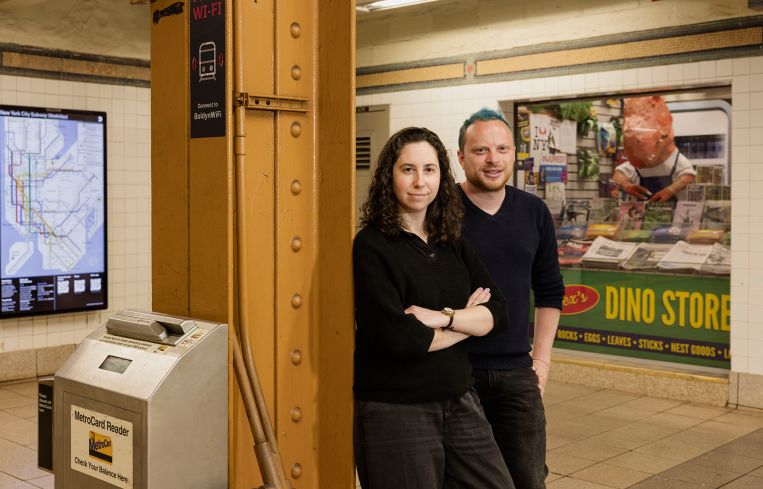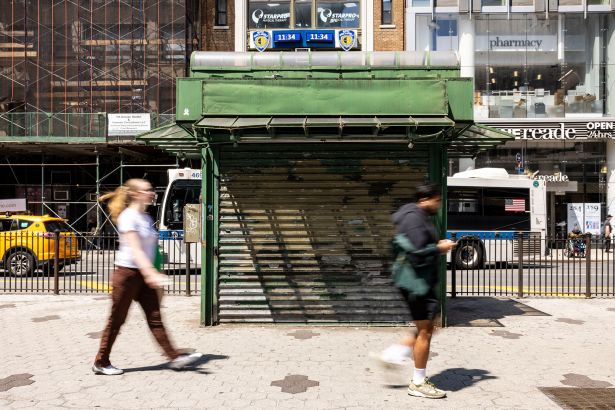The Fight Is On to Save New York City’s Incredibly Shrinking Newsstands
And not necessarily with newsprint, but rather through art exhibits or turning them into tiny drugstores
By Aaron Short May 16, 2025 11:08 am
reprints
In a corner of Brooklyn’s Grand Army Plaza subway station, a new stall is offering newspapers, cigarettes and pain relievers so old they may as well be extinct.
Rex’s Dino Store offers harried commuters a glimpse of scratch-off lotto games like “Meteor Millions” or copies of Triassic-era broadsheets, The Maul Street Journal, The Pangea Times and the Jurassic Park Slope Courier (lead story “Chew On This: Food Co-op tears itself apart over Boycott, Digest, and Stomp Movement”).
But nothing at the subterranean newsstand is available for purchase despite the presence of Rex, the 7-foot-tall papier-mâché tyrannosaurus manning the booth 24/7 behind a plexiglass window.
“We’ve had people come by and say, ‘Oh is it for sale?’ No, it’s art, and they’re disappointed,” said Brooklyn artist Sarah Cassidy, who created the exhibit with artist Akiva Leffert.
The reptile-friendly display is part of the Metropolitan Transportation Authority’s initiative to activate 30 unused retail spaces in the subway by leasing them at no cost to artists and cultural organizations for art installations or educational programming.
It’s a creative solution to a long-term problem of shrinking newsstands and making public spaces more inviting. The number of newsstands in the city has been collapsing for decades from more than 1,500 in the 1950s to roughly one-fifth that number today.
At the same time, the MTA has been struggling to fill its subterranean retail spaces, some of which are as small as 7.5 square feet. Six years ago, 40 percent of the MTA’s 326 retail spaces were occupied.
But many of its tenants, including news kiosks, restaurants and record stores, went out of business during the COVID-19 pandemic, and the agency has been unable to replace them. Last year, New York’s subway ridership began to approach pre-pandemic levels, but more than 80 percent of retail sites in transit hubs remained unoccupied.
Transit officials and the city’s Department of Consumer and Worker Protection (DCWP) have stepped up their marketing efforts to lure entrepreneurs into available newsstands through campaigns like the Vacant Unit Activation Program. This year, only 62 out of the authority’s 203 retail locations, or 30 percent, are vacant while the rest are open or in active negotiations with retailers, an MTA spokesperson said.
But the business of selling glossy magazines, tabloids and cigarettes to smartphone-addicted commuters has gotten even harder in recent years. And the city’s existing newsstand operators say they are boxed in by restrictions over the prices of their wares and what they can sell. In the meantime, government agencies are giving away some of their stores for free.
“That is not a business that seems to be economic anymore for those folks,” MTA CEO Janno Lieber told The City last summer. “So we’ve been trying to figure out how to energize and enliven those spaces.”
Running a New York newsstand, whether it was underground or on street level, was challenging even before the pandemic sapped the city’s steady stream of commuters and tourists.
Thanks to rapid consolidation in the media industry in the 21st century, newsstand revenue dropped from $6.8 billion in 2006 to about $1 billion in 2022. As fewer magazines and newspapers were published, newsprint sales at newsstands fell from a high of 35 percent of total circulation in the 1970s to about 10 percent by the early 2000s, and then to less than 3 percent by the end of the pandemic, according to Poynter.
It hasn’t helped that daily newspaper circulation has declined by two-thirds over the same period, from a peak above 60 million in the 1990s to just under 21 million in 2022. New York’s tabloid newspapers — a top seller at city newsstands — haven’t been spared, either. In August 2007, the New York Post and New York Daily News each had a daily circulation of about 700,000 copies. By 2023, the Post recorded about 131,000 copies and the News measured just above 45,000 copies.
Fewer print products to sell to a public that has been less inclined to read them led to the erosion of newsstands throughout the city. There are currently 357 newsstands in New York City and 331 of them have active licenses, according to DCWP. That’s a 9 percent increase above the 304 licenses that were active in 2021 during the pandemic. (Several kiosks are on park property and dozens of others are overseen by the MTA, but the agency did not have a precise figure distinguishing news vendors from other retailers.)
But an aging and dwindling customer base isn’t newsstands’ only challenge.
City rules prevent newsstand operators from selling any of their products above a mere $10. There are a handful of exceptions for items such as cigarettes and prepaid phone cards, but newsstands aren’t able to carry more expensive candies and beverages — the prime movers these days — or higher-quality accessories such as phone chargers, headphones, hats or umbrellas that people may need when they walk by. The last time the City Council raised the price cap was in 2013, when the lid rose from $5 to $10, but lawmakers haven’t adjusted the figure since.
In addition, newsstands are permitted to sell only prepackaged food and can’t offer prepared meals like sandwiches, salads and baked goods that could fetch higher prices.
Phil Dorn, counsel to the New York City Newsstand Operators Association, wants the city to raise the cap to $15 and allow a greater variety of prepared foods to be sold.
“Many of them are first-generation immigrants who could make an honest living, and that would be great,” he said. “We don’t expect them to start allowing them to start opening restaurants in their newsstand or flipping burgers, but they could do more than a pack of Skittles.”
Running newsstands has also gotten less safe and more expensive. Dorn said his clients have complained about a rise in thefts and assaults at their newsstands since the pandemic, especially overnight.
The newsstand association’s attorneys, too, have had to resolve several of his clients’ summonses for selling cigarettes to undercover agents, which can cost $100 per day for every day they have committed a violation. Last year, DCWP inspectors issued 41 summonses for selling unlicensed tobacco and e-cigarettes, more than double the 20 they issued in 2023.
Dorn believes the city is cracking down on vendors in order to phase out their licenses.
“It seems as if the current administration has little interest in supporting tobacco retail dealers,” he said. “A minor penalty violation can lead to a major financial penalty if not a loss of license with little to no ability to regain that license. Once they get charged $40,000 in fines, they shutter the business and no one can get a tobacco license in that space, and it’s one fewer newsstand.”

The city and the MTA have instead turned to artists and cultural organizations to enliven spaces that in some cases have stood vacant for nearly a decade.
Since launching the program in November 2023, the MTA has partnered with arts institutions including the Whitney Museum, the Center for Brooklyn History at the Brooklyn Public Library and nonprofit studio space provider Chashama. The DCWP also helped keep an Upper West Side newsstand open after the death of its original licensee and worked with Bronx Councilman Rafael Salamanca to convert a long-defunct newsstand into an arts installation.
Some artists, including Cassidy and Leffert, simply applied to the MTA’s vacant retail program with their idea for turning the vacant Grand Army Plaza subway shop into a prehistoric newsstand. After a year of planning, in which the MTA fixed a large hole in the floor and Cassidy and Leffert designed and produced dozens of fake newspapers, snacks and drugs, they opened their dinosaur bodega in early May.
“It was low-key baffling to us that the MTA was just letting some randos like us take over prime subway real estate, though we think we’ve earned the trust they put in us,” Leffert said. “We’d never collaborated before and it’s worked out really smoothly.”


